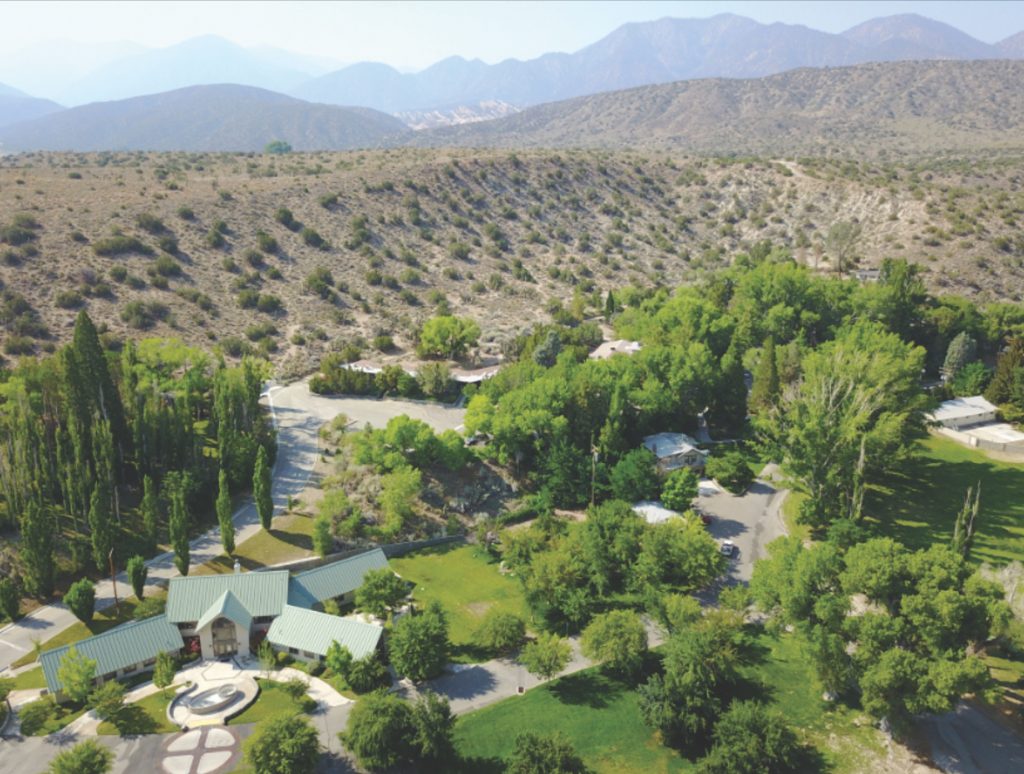If, like me, you’re forever in search of a day or two of silence and solitude, do I have a place for you.
That would be St. Andrew’s Abbey, a male Roman Catholic Benedictine monastery in the high desert 1 1/2 hours outside LA. You can either cut through the Angeles Forest, or take the long way around up the 5 to the 114 to Route 138 (aka the Pearblossom Highway).
That will land you in the unincorporated community of Valyermo, on which, down a winding back road, St. Andrew’s is located. Pearblossom, Valyermo: pure poetry, and wait till you actually arrive!
Benedictines are known for their hospitality, and one of the abbey’s main offerings consists of retreats. I’ve done many over the years: a few directed, most private. You get a room with heat, a swamp cooler, a bed, a desk, a patio, and a crucifix (WiFi is available in the guest lounge). You get acres of gorgeous desert to explore and roam. At 3,600 feet, nestled in the northern foothills of the San Gabriel Mountains, you get four seasons.
Spring is an explosion of colors, textures, and the fragrance of chaparral and sage. Summers are hot, all the better to enjoy the shade of the Lombardy poplars, cottonwoods, and chapel. In fall, the trees change color. I spent Christmas here the year my mother died and woke Dec. 25 to snow.
The abbey is named for its motherhouse in Brugge, Belgium. Several missionary monks who had been expelled from Communist China bought the Hidden Springs Ranch in Valyermo and in 1955 established the monastery. Today, 20 monks make their lives of “ora et labora” (“pray and work”) there.
You can sign up for a guided retreat at the abbey and learn more about St. Hildegard of Bingen, Thomas à Kempis, Father Henri Nouwen, Father Teilhard de Chardin, 12-step spirituality, or “Caring for Our Common Home.”
Other 2020 offerings include “Discernment in Daily Life,” “Faith and the Human Condition: The Writings and Relationship Between Adrienne von Speyr and Hans Urs von Balthasar,” and the one I’d be most likely to sign up for: “Poverty of Spirit.”
You can request spiritual direction or the sacrament of reconciliation, on weekdays visit the ceramics factory, or simply wander.
You can also come to the abbey to ponder a decision, nurse a wound, plan a project, or process an epiphany. The first time I spent serious time here was in 2000, right after I’d received a cancer diagnosis. Amid the silence, beauty, and cottontail rabbits, I learned how to pray the Divine Office, a practice that’s sustained me ever since.
All these years later, I’ve begun taking steps to become an oblate, “a layperson connected with a religious order or institution and living according to its regulations,” at St. Andrew’s.
Recently my brother Ross and I, coming from different directions, made a day trip to the abbey. He’d never been before and couldn’t get over the landscape, sky, and general loveliness. The day was sunny and clear, with a light breeze, and beneath the coolness a layer of warmth from the sun.
If I do become an oblate, I could choose to be buried at the abbey.
The cemetery is situated up a hill with a dirt trail, making a trek there a mini-pilgrimage. As we climbed, below was a valley and all around were snow-shrouded mountains. “Just think, Roscoe,” I told my little 6-foot-4-inch brother, “someday you might be carrying my ashes up here!”
We went to noon Mass together, then ate with the monks and other visitors in the refectory.
Monks bring around soup to each guest, a moving gesture of hospitality, after which we all helped ourselves from the buffet table. Afterward I had a meeting with Father Francis Benedict.
“So what about the oblateship?” I asked, always eager to do penance, check items off a long, difficult list, prove myself, and earn a crumb of love.
“Just come and be with us,” Father Francis replied. “Make a retreat, stay a night or drive out for the day, continue to come to the monthly meetings. Make friends with the other oblates. We just want you to be part of us, of the community.”
Nothing is certain, of course. I won’t be eligible even to make informal vows for another six months.
But that was when I knew I’d found a new home, one I didn’t even know I’d been looking for all my life.
What could be more simple, more balanced, more sane, and in its way more difficult, than participating in community? Connection is what we crave and what we will go to any lengths, often unbeknownst to ourselves, to avoid.
Already I felt a little closer to believing perhaps the hardest thing for us fallen human beings to believe: that we’re worthy of love, just as we are.
The Welcome Center, opened in 2008, houses the Conference Center, and Abbey Books and Gifts.
I stopped in the bookstore before I left, trailing my fingers over the treasure trove of titles yet to be read.
Then, sensing I’d be making this trek often in the coming years, I treated myself to a wall icon of St. Christopher: patron saint of travelers.

